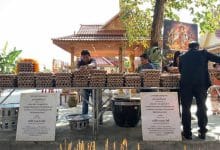Phra Aram Luang Monastery sees surge in visitors seeking fortune from revered Luang Pho Pak Daeng

An increased number of visitors are travelling to Phra Aram Luang Monastery, also known as the Monastery of Luang Pho Pak Daeng in Nakhon Nayok province, to pay respects and seek good fortune from the revered image of Luang Pho Pak Daeng. The sacred image, positioned in the temple’s Ubosot, is a significant religious figure in the locale.
The image of Phra Aram Luang holds strong sentimental and spiritual significance for the locals, making it an essential aspect of their faith. The respect and admiration bestowed upon the image by locals have led the temple to become one of the most critical tourist sites in the Nakhon Nayok province. Worship rituals performed by visitors typically encompass offerings such as flowers, bananas, betel nuts, garlands, and red water, which the temple provides for devotion.
A particular allure for lottery enthusiasts visiting Phra Aram Luang is the chance to discover lucky numbers hinted at in the water basin. Many visitors feel their luck has heightened after returning from the temple visit. This time around, the digits noted include nine, five, zero, six, and three. However, these numbers are subject to interpretation, and different visitors perceive them in various ways. Visitors usually take photos of the numbers they perceive and bring them back home to try their luck in the forthcoming lottery draw.
Following the reverential act towards Phra Aram Luang, believers often proceed to crawl through the elephant statue in front of the Ubosot, wishing for prosperity and good fortune. Another popular spot capturing the interest of many travellers is the coffin, believed to improve one’s life and counter ill luck. The activities undertaken at the coffin are meant to cure illness and transform life, in line with individual beliefs reported Sanook.
A person wishing to take part in the Phra Aram Luang ceremony lies supine in the coffin, hands folded, head pointed westward, mimicking the position of the deceased.
Subsequently, a monk covers the coffin with a white shroud akin to a mortuary sheet and recites the requiem chants. The participant in the coffin is encouraged to meditate on the good in life and dedicate merit to beings in the afterlife. This ritual, according to popular belief, is akin to experiencing death before actual death, improving fate and life quality, according to every individual’s belief. The temple arranges this life-enhancing ceremony daily.
Latest Thailand News
Follow The Thaiger on Google News:


























